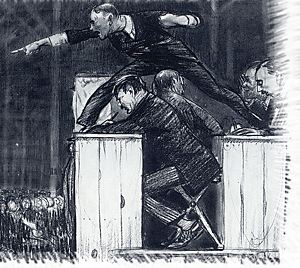 |
| 1882 | Born in Columbus, Ohio. |
| 1897 | Enters Central High in Columbus, Ohio. |
| 1901 | Enrolls at Ohio State University and drawings begin to appear in student publications. |
| 1904 | Leaves college and goes to New York City to enroll in the Chase School of Art. Studies with Robert Henri. |
| 1905 | Paints Central Park. |
| 1907 | River Rats is exhibited at the National Academy of Design. Makes first boxing picture. |
| 1908 | Exhibition of The Eight opens at the MacBeth Gallery. Paints North River and wins the second Hallgarten Prize at the National Academy of Design show. |
| 1909 | Sells North River to Pennsylvania Academy of the Fine Arts. Paints Stag at Sharkey's. |
| 1910 | Exhibits in the Independent Artists Exhibition. Appointed life class instructor at Art Students League. Marries Emma Story. |
| 1911 | One man show at Madison Gallery. Organizes an exhibition of The Eight. |
| 1912 | Accepts commissions for magazine illustrations. Has one man show in Columbus. |
| 1913 | Works on installation of Armory Show and is too busy to paint. Exhibits Little Girl in White at National Academy of Design where he receives the Hallgarten Prize and become a full Academician. |
| 1914 | Has exhibits at Montross Gallery and three major museums. |
| 1915 | Furor over Olney portrait at Harvard Club, including disagreement over whether he should be paid. |
| 1916 | Makes first lithographs. |
| 1917 | One man show at Milch Galleries. |
| 1918 | Begins a series of lithographs and oils depicting German atrocities during WWI. |
| 1919 | Has exhibit at Knoedler & Co. and sells several paintings. Has an exhibit at Albright Art Gallery and in Chicago where he is teaching. |
| 1920 | Spends most of his time painting. |
| 1921 | Has an exhibit with Thomas Eakins at Ferargil Galleries. |
| 1922 | Sells Stag at Sharkey's to Cleveland Museum of Art. Builds house in Woodstock. Starts to paint in earnest again. |
| 1923 | His mother dies. Makes over 40 lithographs. |
| 1924 | Goes to Woodstock and starts to paint again. |
| 1925 | Appendix ruptures on Jan. 2 and dies of peritonitis(Jan. 8). |
